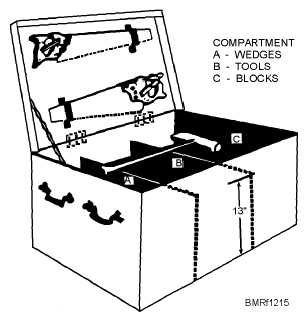DAMAGE CONTROL SHORING CHEST
Each repair station has a damage control shoring
chest (fig. 12-15). The chest is divided into three
compartments to separate the different tools and
materials needed for shoring.
REVIEW 8 QUESTION
Q1. Describe the purpose of the following items.
a. Damage control shoring chest
b. P-100 pump
c. Firefighter ensemble
d. Anti-flash clothing
e. Fire hose station
SUMMARY
A ship lives or dies depending on its crew’s ability
to combat a wide range of casualties, and these
casualties are not restricted to times of conflict.
Casualties can occur while moored in your homeport,
at anchorage overseas, or during a routine peacetime
deployment. The requirement for every person on
board, from the commanding officer to the fireroom
messenger, to have a good, basic knowledge of damage
control procedures and constant training and drills in
combating shipboard casualties is essential to the
ship’s survival. This training and preparation
demonstrated during the Persian Gulf crisis saved
several U.S. Navy ships that sustained considerable
damage. If these crews had not been trained in damage
control, these ships and most likely a large portion of
their crews may have been lost.
The proper use of the closure log is just as
important as knowing how to don an OBA or use a fire
hose. The business of damage control is serious. Learn
it well; your life, the lives of your shipmates, and your
ship depend on it.
REVIEW 1 ANSWERS
A1.
The damage control organization is divided into
the—
a.
Administrative organization
b.
Battle organization
A2.
The purpose of the administrative phase of DC
is to establish and maintain material
readiness conditions.
A3.
The engineer officer is responsible for
maintaining properly trained DCPOs, repair
parties, and repair locker personnel.
A4.
The XO is the senior person assigned as team
leader on DCTT.
12-26
Figure 12-15.—Damage control shoring chest.
Student Notes:


